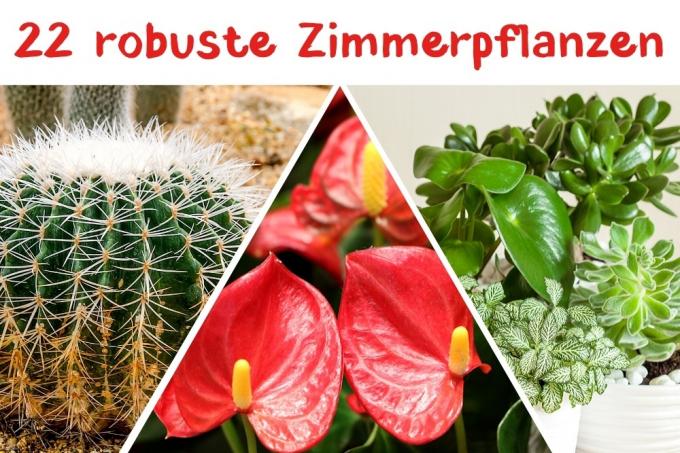
table of contents
- Flowering plants
- Green plants
- Cacti
Houseplants make an apartment cozy in the first place, and they also contribute significantly to healthy indoor air. Now not everyone has a “green thumb”. Fortunately, however, there are numerous robust and easy-care species of flowering and green plants. We present the 22 most beautiful ones to you here.
Flowering plants
Particularly popular as indoor plants are flowering plants that set special accents with their colorful flowers. Many blooming beauties such as blue lizards or slipper flowers belong to the so-called seasonal or disposable flowers. They are no longer cared for after flowering because their lifespan is limited to one year or they are very difficult to overwinter. So, there is not much you can go wrong with these types. Other flowering plants bloom tirelessly and become more beautiful and bigger from year to year.
Echeverie (Echeveria)

The small echeveria are decorative, very easy to care for and robust houseplants with little space requirement. There are around 100 different species, almost all of which have fleshy leaves arranged in a spiral to form rosettes. The pretty flowers are brightly orange-yellow or orange-red in color.
- Origin: southern USA, Central and South America
- Toxicity: no
- Flowering time: depending on the type and variety in winter, spring or summer
- Location: full sun all year round
- Temperature: warm in summer, cool in winter at 5 to 10 ° C
- Watering: little in summer, not at all in winter
- Fertilization: apply some cactus fertilizer weekly from March to August
- Propagate: by side rosettes or leaf cuttings
- Special features: grow best in cactus soil
Single leaf (Spathiphyllum)
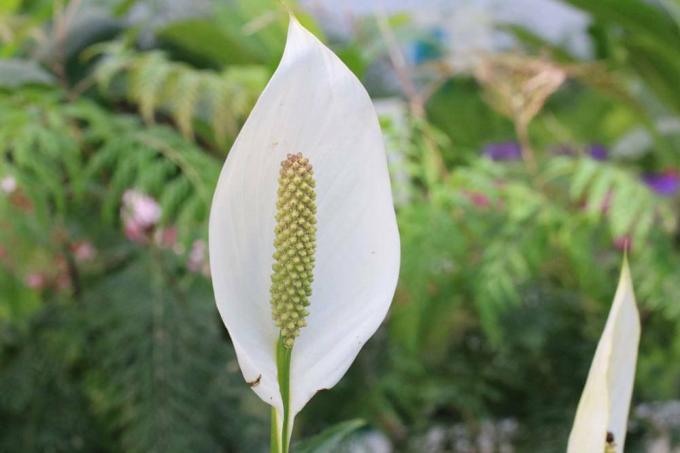
The single leaf, also known as the leaf flag, is one of the most popular indoor plants for the home and office. The species prefers to be bright, but is surprisingly adaptable in terms of light intensity - the plant also thrives very well in the shade.
- Origin: Colombia, Venezuela
- Toxicity: contains substances irritating to the skin and mucous membranes
- Flowering period: March to September
- Location: bright to partially shaded
- Temperature: warm all year round at 18 to 25 ° C
- Watering: moderate, a little more during the summer months
- Fertilizing: from March to August every 14 days, weakly dosed
- Increase: by division
- Special features: spray more often
Flamingo flower (Anthurium)
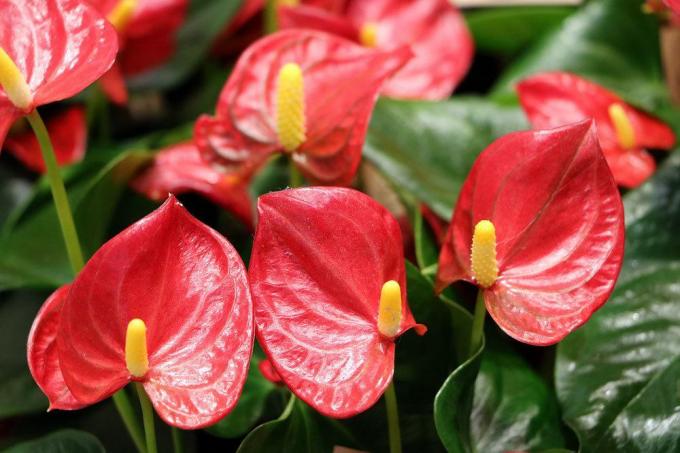
The actual bloom of the popular flamingo flower - also a very robust houseplant - is not the conspicuously red, pink or white colored bract, but the one protruding there Pistons. The species Anthurium crystallinum has particularly beautifully drawn leaves.
- Origin: Central and South America
- Toxicity: contains substances irritating to the mucous membranes
- Flowering time: all year round
- Location: needs a lot of light, but must not be in direct sunlight
- Temperature: warm all year round
- Watering: keep evenly moist
- Fertilizing: weekly between March and September, weakly dosed
- Increase: by division
- Special features: spray regularly
Bottle plant (Jatropha podagrica)
The bottle plant, also known as the “rhubarb of Guatemala”, comes from regions with periods of drought and always has its water supply ready. It is therefore the right plant for those who often forget to water.
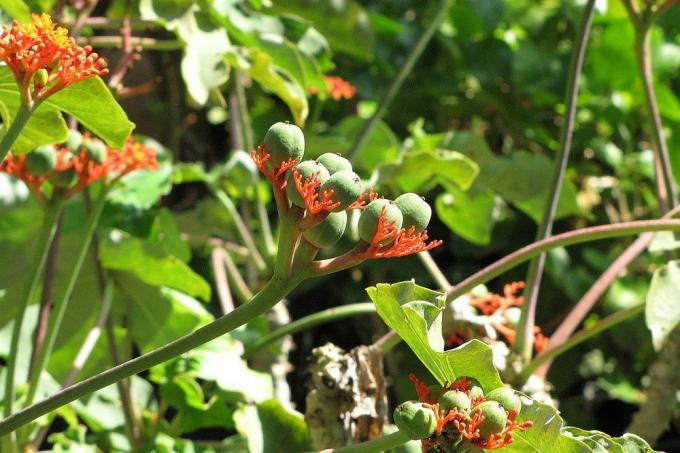
- Origin: Nicaragua, Guatemala, Costa Rica
- Toxicity: yes, all parts of the plant are poisonous
- Flowering time: March to July, with good care all year round
- Location: full sun, needs a lot of light
- Temperature: warm all year round, not below 16 ° C
- Watering: watering little
- Fertilizing: once a week with cactus fertilizer (only in summer)
- Propagate: from fresh seeds
- Special features: loses its leaves in autumn, sprouts again in spring
Green plants
Due to their different growth forms, leaf sizes, structures and colors, green plants are wonderfully suitable for decorating living spaces. Hanging species can flow down from pillars or pedestals, or hang from the ceiling. Plants that grow into stately indoor trees are particularly eye-catching. The effect that green houseplants have on us is also not to be underestimated: green is calming and has a relaxing effect.
Tip: Many types of indoor plants can be grown very well in hydroponics and are therefore particularly easy to care for. This form of culture is particularly recommended for office greening or for people who travel a lot and cannot water regularly.
Bow hemp (Sansevieria)

Bow hemp was already in culture in Austria in 1770. It is still very popular today, which is certainly due to its fabulous toughness. Sansevieria are almost indestructible and therefore wonderfully robust indoor plants.
- Origin: Tropical West Africa
- Toxicity: yes, contains saponins
- Sunny to partially shaded location
- Temperature: room temperature all year round
- Watering: watering little, always let dry in between
- Fertilizing: between March and August every two to three weeks, use flower or cactus fertilizer
- Propagate: leaf cuttings, division of the secondary shoots
- Special features: air-purifying, therefore very suitable for the bedroom
Thick leaf / money tree (Crassula)

There are two types of thick leaf, also known as money or penny trees, that are often cultivated as indoor plants, Crassula arborescens and Crassula ovata. Both grow multi-shoot to tree-like and form stately, gnarled-looking specimens more than a meter in height and circumference. The money tree can get very old with good care and, rarely before ten years, sets small pink or white flowers.
- Origin: South Africa
- Toxicity: no
- Location: bright to full sun, avoid midday sun
- Temperature: warm in summer, approx. 10 ° C as cool as possible
- Watering: moderate in summer, keep almost dry in winter
- Fertilize: once a month in summer with cactus fertilizer
- Propagate: very easily by cuttings from the head
- Special features: needs a stable and heavy pot
Dragon tree (Dracaena)

Dragon trees are uncomplicated and robust houseplants that also cope well with shade. There are a number of different species that do not differ in terms of location preferences and care.
- Origin: Africa and Madagascar, Asia (v. a. Southeast Asian Islands), Canary Islands
- Toxicity: slightly toxic, especially for cats, dogs and rodents, contains saponins which irritate the mucous membranes
- Location: bright to partially shaded, but not full sun
- Temperature: room warm all year round
- Watering: keep slightly moist evenly
- Fertilizing: fertilize every two weeks between March and August
- Propagate: by trunk pieces, head cuttings or partial cuttings
- Special features: Dragon trees do not tolerate leaf gloss spray
Efeutute (Epipremnum pinnatum)
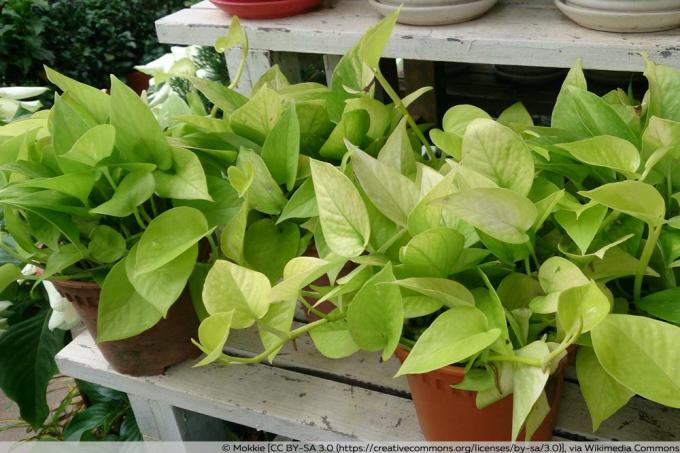
With its long shoots, the Efeutute is wonderfully suitable as a hanging traffic light plant, but can also be used for lush greening of room dividers or walls. The plant is as decorative as it is undemanding.
- Origin: Solomon Islands (Pacific)
- Toxicity: yes, like all arum plants
- Location: bright, partial shade or shade - is undemanding in this regard
- Temperature: room temperature all year round
- Watering: keep evenly moist
- Fertilizing: weekly between March and August
- Propagate: head and partial cuttings (root in a glass of water)
- Special features: very suitable for trellises, good plant for hydroponics
Elephant foot (Beaucarnea recurvata)

The elephant foot is easy to identify: it forms a wide thickening at the base of the trunk in which the plant stores water for dry periods and which gives it a bizarre appearance to lend. The agave plant needs a lot of light, but only little water.
- Origin: Mexico
- Toxicity: slightly toxic, contains saponins which irritate the mucous membranes
- Location: bright to full sun
- Temperature: airy, not below 10 ° C in winter
- Watering: moderate, keep almost dry in winter
- Fertilizing: every four weeks from May to October
- Increase: by side shoots
- Special features: it is better to water too little than too much!
Window leaf (Monstera deliciosa)

Beautifully cut leaves and impressive growth have made the window leaf one of the most popular robust indoor plants. With good care, this creeper forms shoots up to five meters long and numerous aerial roots. Therefore, it also needs a scaffold or an epiphyte trunk to hold on to.
- Origin: Mexico
- Toxicity: yes, like all arum plants
- Location: bright but not sunny
- Temperature: room temperature all year round, preferably high humidity
- Watering: keep moderately moist all year round
- Fertilizing: every 14 days from March to August, low dose
- Propagate: by cuttings or mosses
- Special features: also thrives very well in the shade
Green lily (Chlorophytum comosum)

The green lily is very easy to care for and quickly surrounded by a bunch of children. It thrives everywhere. The original form is green-leaved, but the variants with striped leaves are better known.
- Origin: South Africa
- Toxicity: no
- Location: sunny, bright or partially shaded
- Temperature: room temperature all year round
- Watering: keep slightly moist all year round
- Fertilizing: weekly between March and August
- Increase: at any time by Kindel
- Special features: very suitable as a hanging traffic light plant
Rubber tree (Ficus elastica)

The popular rubber tree is one of the most uncomplicated houseplants and is closely related to the Ficus benjamina, the weeping fig. Many other ficus plants also make a robust interior decoration as houseplant, including the climbing ficus Ficus pumila. This in turn is very suitable as a hanging traffic light plant.
- Origin: tropics and subtropics
- Toxicity: slightly toxic
- Location: very bright, but not sunny
- Temperature: room temperature all year round
- Watering: moderate, very little in winter
- Fertilize: every 14 days in summer
- Propagate: by cuttings or mosses
- Special features: spray more often
Piston thread (aglaonema)
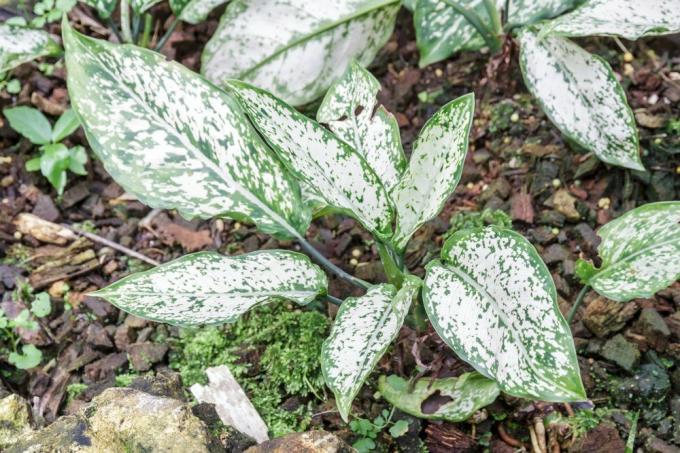
The trademark of the piston thread is the silver markings on the leaves. The attractive houseplants form stems up to 50 centimeters high with broad oval leaves, can bloom and form red berries after blooming.
- Origin: Southeast Asia
- Toxicity: yes, like all arum plants
- Location: partial shade to shade, gets along very well with little light
- Temperature: warm all year round, not below 16 ° C
- Watering: water moderately in summer, less in winter
- Fertilizing: every 14 days from March to August, low dose
- Propagate: by division or head cuttings
- Special features: do not spray
Palm Lily (Yucca elephantipes)
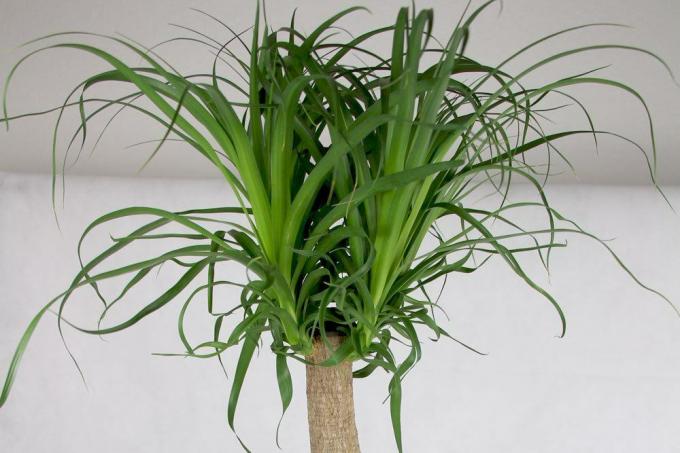
Yucca elephantipes with a bulbous thickening at the base has been popular as houseplants since time immemorial Trunk and rather loose scoops of dark green, up to 100 centimeters long, sword-shaped Scroll.
- Origin: Central and South America
- Toxicity: yes, especially highly toxic to pets
- Location: very bright and sunny
- Temperature: warm in summer, cool in winter at around 10 ° C, all year round
- However, room temperature is tolerated
- Watering: moderate, little in winter
- Fertilizing: every three weeks from March to August
- Propagate: by trunk pieces or side shoots
- Special features: yuccas that have become too tall can be shortened at any point
Cobbler palm (Aspidistra elatior)
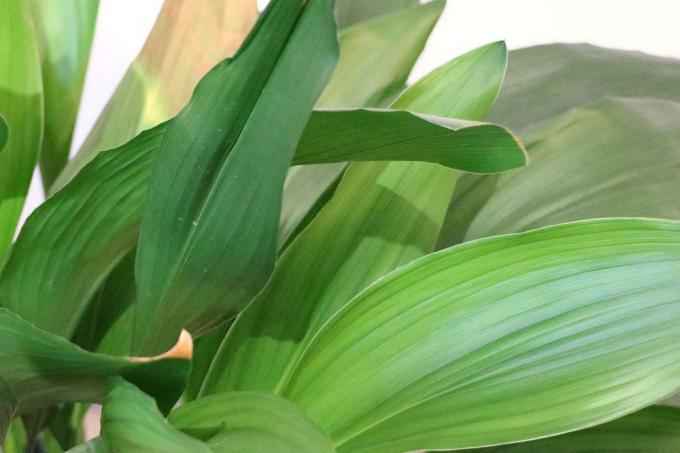
The cobbler palm is the epitome of all easy-care and robust houseplants. The lily plant grows and thrives everywhere, and it can also cope with the little light that stairwells, corridors or business premises offer.
- Origin: China and Japan
- Toxicity: no
- Location: light to shady, by no means sunny
- Temperature: fresh and cool all year round, but not below 10 ° C
- Watering: keep moderately moist, almost dry in winter
- Fertilizing: every two weeks between March and August
- Propagate: by dividing the rhizome
- Special features: also tolerates warmer temperatures and dry room air
Radiant Aralia (Schefflera)
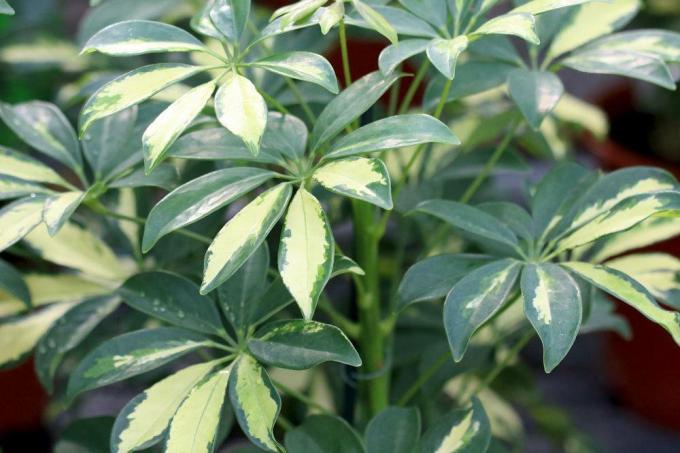
The Schefflera's willingness to grow shows that it grows as a shrub or tree in its home. The hand-shaped arrangement of the leaves is characteristic of this attractive houseplant.
- Origin: Taiwan, Northeast Australia, New Guinea
- Toxicity: contains substances irritating to the skin and mucous membranes
- Location: bright to partially shaded
- Temperature: as cool as possible, in winter at 12 to 16 ° C (but also tolerated
- Room temperature very good)
- Watering: always keep slightly moist
- Fertilizing: every 14 days from March to August
- Propagate: head or partial cuttings, mosses
- Special features: grows well on the moss stick
Spurge (Euphorbia)
The large spurge family also includes cactus-like, leafless succulents. They are bizarre, undemanding houseplants, not a few of which look confusingly similar to cacti.

- Origin: Africa
- Toxicity: toxic for humans and animals, beware of the milky juice
- Location: bright to full sun
- Temperature: warm in summer, 15 to 18 ° C in winter
- Watering: little all year round, just pour directly onto the ground
- Fertilize: between April and September with weakly dosed cactus fertilizer
- Propagate: by cutting off plant parts or cuttings
- Special features: very suitable for hydroponics, otherwise cultivate in cactus soil
Cacti
There are also numerous very robust houseplants among the cacti. The prickly fellows not only look pretty and are ideal for building a collection, they can also tolerate a lot of care mistakes - with the exception of too much moisture. In summer you can water the plants heavily, it is important that no waterlogging remains in the pot and is only watered again when the substrate is completely dry. The cacti presented here thrive on a bright and warm window sill and are easy to make to bloom.
Tip: Most cacti take a winter break. Reduce watering from October, stop fertilizing and, if possible, keep the plants in a cool place at around 10 ° C. In this case, you no longer need to water them. If they are a bit warmer, an occasional sip of water is advisable.
Golden ball cactus (Echinocactus grusonii)
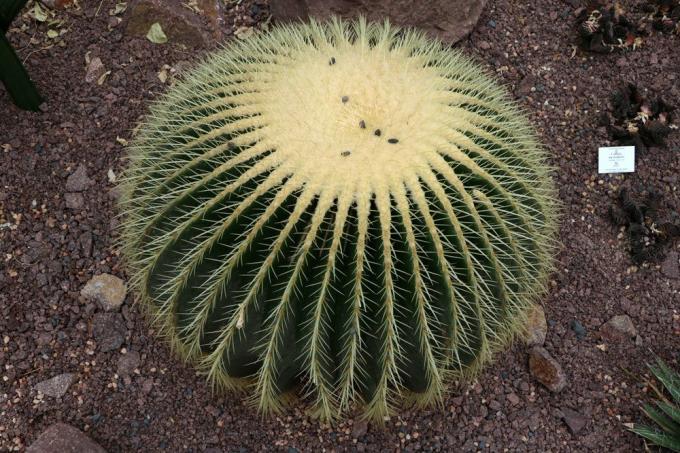
The hedgehog or gold ball cactus grows up to one and a half meters high in its Mexican homeland. The golden yellow thorns are characteristic. The bright yellow flowers, on the other hand, only appear with age, at the earliest when they are about 60 centimeters in diameter.
Easter cactus (Rhipsalidopsis hybrids)
The Easter cactus is a sturdy and flowering houseplant that produces an abundance of bright pink to purple flowers in spring. The cactus species grows as an epiphyte in its home and develops long, drooping leaf limbs with age.

- Origin: Brazil
- Flowering period: March to May
- Location: bright to partially shaded
- Temperature: warm, between November and January for eight weeks of winter rest at approx. 10 ° C (promotes flower formation)
- Watering: keep slightly moist, watering only a little during the rest period
- Fertilizing: give cactus fertilizer occasionally in summer
- Propagate: through shoot members, like cuttings, take root in the growing medium
Rebutia
The different species of this easy-to-care-for and happy-growing genus can be found on every window sill - the cacti are a maximum of eight centimeters high and just as wide. However, they sprout very strongly and soon form small groups. Fine thorns envelop the body of the cactus. The colorful, up to five centimeters large flowers often appear so numerous that they cover the whole cactus. These types are particularly recommended:
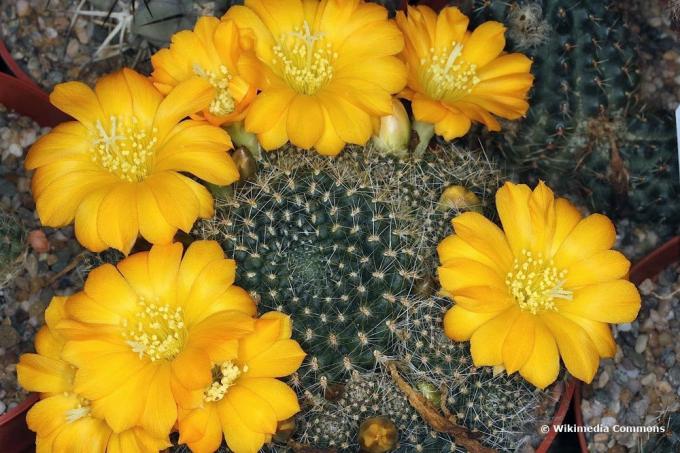
- Rebutia marsoneri (yellow flowering)
- R. violaciflora (violet flowering)
- R. senilis and varieties (yellow and red flowering)
Wart cactus (Mammillaria)
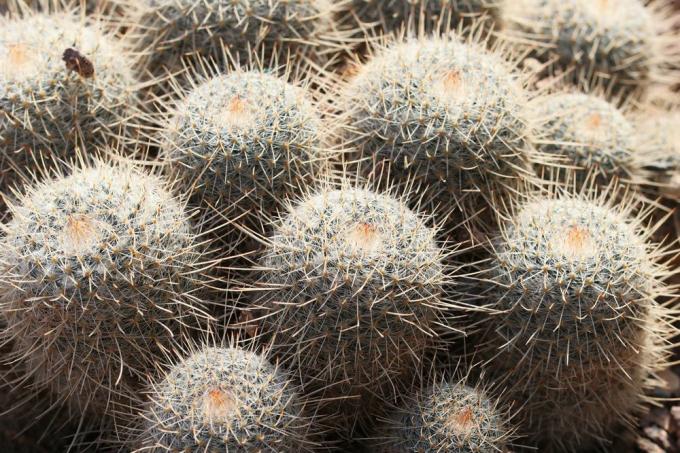
The German name Wartenkaktus indicates that all mammilaria have ribs dissolved in warts. The cacti, which are flat, spherical, slender and thick-columned, depending on the species, have different thorns. Almost all of them sprout strongly and form cushions. There are up to 50 centimeters large and tiny, only a few centimeters high species. They mostly bloom in spring.
Christmas cacti (Schlumbergera hybrids)
Adorable hybrid varieties with white, pink, red, crimson and purple flowers are commercially available. With a bit of luck you will also catch one of the newly bred yellow varieties such as 'Gold Charm'. In winter, the Christmas cactus brings color into the office.

- Origin: Brazil
- Flowering period: December to January, occasionally until March
- Location: bright to partially shaded, little direct sun
- Watering: keep moderately moist in summer, water less from August
- Fertilizing: every 14 days between March and August
- Propagate: by leaf cuttings
- Special features: if possible leave it in one place, otherwise it will quickly lose the flower buds
